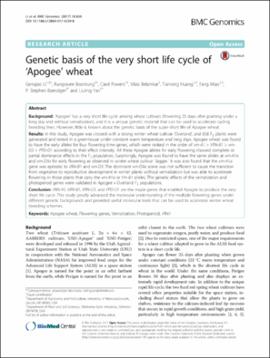| dc.contributor.author | Li, Genqiao | |
| dc.contributor.author | Boontung, Rungravee | |
| dc.contributor.author | Powers, Carol | |
| dc.contributor.author | Belamkar, Vikas | |
| dc.contributor.author | Huang, Tianrong | |
| dc.contributor.author | Miao, Fang | |
| dc.contributor.author | Baenziger, P. Stephen | |
| dc.contributor.author | Yan, Liuling | |
| dc.date.accessioned | 2019-08-21T22:01:24Z | |
| dc.date.available | 2019-08-21T22:01:24Z | |
| dc.date.issued | 2017-10-31 | |
| dc.identifier | oksd_li_geneticbasisoft_2017 | |
| dc.identifier.citation | Li, G., Boontung, R., Powers, C., Belamkar, V., Huang, T., Miao, F., Baenziger, P. S., & Yan, L. (2017). Genetic basis of the very short life cycle of 'Apogee' wheat. BMC Genomics, 18(1). https://doi.org/10.1186/s12864-017-4239-8 | |
| dc.identifier.uri | https://hdl.handle.net/11244/321188 | |
| dc.description.abstract | Background: 'Apogee' has a very short life cycle among wheat cultivars (flowering 25 days after planting under a long day and without vernalization), and it is a unique genetic material that can be used to accelerate cycling breeding lines. However, little is known about the genetic basis of the super-short life of Apogee wheat. | |
| dc.description.abstract | Results: In this study, Apogee was crossed with a strong winter wheat cultivar 'Overland', and 858 F2 plants were generated and tested in a greenhouse under constant warm temperature and long days. Apogee wheat was found to have the early alleles for four flowering time genes, which were ranked in the order of vrn-A1 > VRN-B1 > vrn-D3 > PPD-D1 according to their effect intensity. All these Apogee alleles for early flowering showed complete or partial dominance effects in the F2 population. Surprisingly, Apogee was found to have the same alleles at vrn-A1a and vrn-D3a for early flowering as observed in winter wheat cultivar 'Jagger.' It was also found that the vrn-A1a gene was epistatic to VRN-B1 and vrn-D3. The dominant vrn-D3a alone was not sufficient to cause the transition from vegetative to reproductive development in winter plants without vernalization but was able to accelerate flowering in those plants that carry the vrn-A1a or Vrn-B1 alleles. The genetic effects of the vernalization and photoperiod genes were validated in Apogee x Overland F3 populations. | |
| dc.description.abstract | Conclusion: VRN-A1, VRN-B1, VRN-D3, and PPD-D1 are the major genes that enabled Apogee to produce the very short life cycle. This study greatly advanced the molecular understanding of the multiple flowering genes under different genetic backgrounds and provided useful molecular tools that can be used to accelerate winter wheat breeding schemes. | |
| dc.format | application/pdf | |
| dc.language | en_US | |
| dc.publisher | BioMed Central | |
| dc.rights | This material has been previously published. In the Oklahoma State University Library's institutional repository this version is made available through the open access principles and the terms of agreement/consent between the author(s) and the publisher. The permission policy on the use, reproduction or distribution of the material falls under fair use for educational, scholarship, and research purposes. Contact Digital Resources and Discovery Services at lib-dls@okstate.edu or 405-744-9161 for further information. | |
| dc.title | Genetic basis of the very short life cycle of 'Apogee' wheat | |
| osu.filename | oksd_li_geneticbasisoft_2017.pdf | |
| dc.description.peerreview | Peer reviewed | |
| dc.identifier.doi | 10.1186/s12864-017-4239-8 | |
| dc.description.department | Plant and Soil Sciences | |
| dc.type.genre | Article | |
| dc.type.material | Text | |
| dc.subject.keywords | apogee wheat | |
| dc.subject.keywords | flowering genes | |
| dc.subject.keywords | vernalization | |
| dc.subject.keywords | photoperiod | |
| dc.subject.keywords | vrn1 | |
